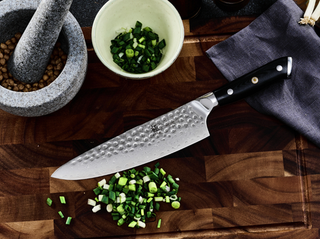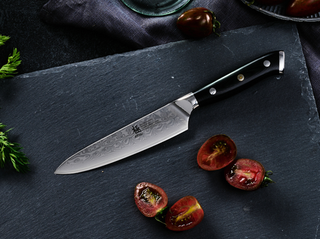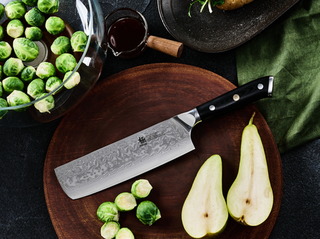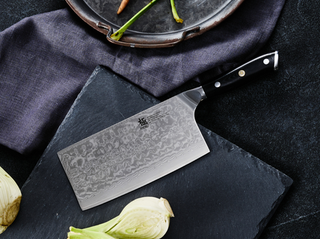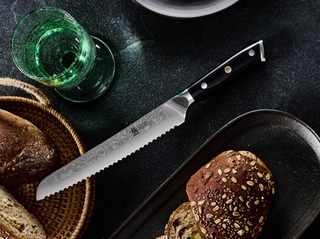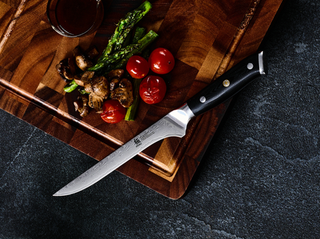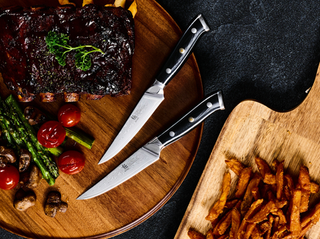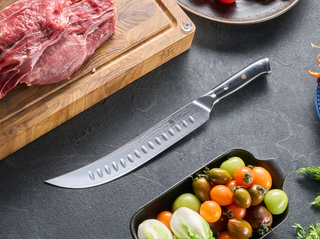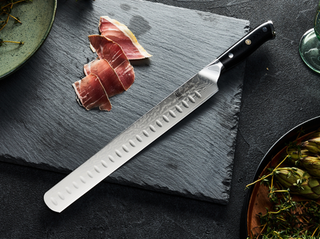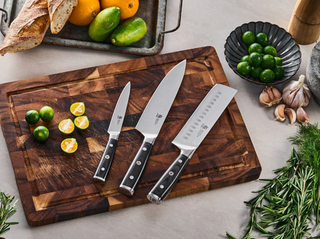Introduction
It is a widely established truth that the quality of kitchen tools greatly improves the cooking experience. A hollow edge knife, typically, the Santoku Knife, is one of the greatest examples of an ideal kitchen tool. This Japanese knife is designed not just for functionality but for precision and ease, making it a good choice for both chefs and home cooks. If you want to buy a new hollow edge knife, especially the hollow edge Santoku knife, knowing what makes the hollow edge Santoku knife unique can help you make a smart choice. This guide will help you learn some important features about hollow edge Santoku knives and how to maintain your high-quality Santoku knives.
What is a Hollow Edge Santoku Knife?
Before getting close to hollow edge Santoku knives, let’s start with what a hollow edge knife is. A hollow edge knife usually features small indentations along the blade, typically known as “Granton edges”. These indentations can create air pockets while cutting, which can help prevent food from sticking to the blade and let you make thinner slices.
The Santoku knife is a typical example of hollow edge knives. The Japanese term “Santoku” can be translated into “three virtues” in English, which can be interpreted to refer to slicing, dicing, and mincing—the three primary tasks that this knife performs with exceptional ease. The Santoku knife is usually crafted with a broad blade and a sharper curve at the tip, which differs from the traditional chef's knife. This design can provide a more manageable balance and a lighter weight, making it perfect for a range of tasks. Developed in the mid-20th century as a home kitchen alternative to some specialized knives used in professional Japanese kitchens, the Santoku knife quickly became popular for its utility.
Important Features of Hollow Edge Santoku Knives
Knowing what makes a hollow edge knife different can help you to make a good choice-whether to buy or how to choose. There are several important features that you can focus on.
1. Strategically Arranged Indentations
The hollow edge design of a Santoku knife can be what you first focus on. Consider the depth and spacing of these indentations. Deeper, more widely spaced grooves generally make it easier for food to slide off the knife and reduce drag.
2. High-carbon Steel or Stainless Steel Materials
Except for the hollow edge design, the blade material is the factor that you should not overlook for any knife. High-carbon steel and stainless steel can be the recommended materials for hollow edge Santoku knives, as they can usually offer sharpness or rust resistance. Ceramic is also an option but knives made of ceramic should be carefully patiently.
3. 15-20 Degrees of the Sharp Cutting Angle
A hollow edge Santoku knife should have a sharp cutting angle. A Santoku knife with a cutting angle over 20 degrees may be too large. Try to find a blade with an angle of between 15 and 20 degrees. It will be better if you manage to find a blade sharpened to less than 15 degrees.
Top Hollow Edge Santoku Knives on the Market
When it comes to choosing a hollow edge Santoku knife, there are numerous options available on the market. Here are some high-quality Hollow edge Santoku knives of different series from Kyoku that can give you a better cooking experience.
1. 7" Japanese Santoku Knives Damascus Steel | Shogun Series
This Santoku knife of the Shogun series is crafted from 67 layers of stainless Damascus steel, making its blade durable and sharp. There is also an elegant herringbone pattern at the base of the tang. Additionally, its strategically placed indentations also enhance the blade's appearance and reduce food sticking.
2. 7" Santoku Knives 440C Steel | Daimyo Series
This Santoku knife of the Daimyo series features a razor-sharp 13–15 degree edge and is constructed from 440C stainless steel. The rosewood handle can also fit comfortably in many kitchen settings. There is also a unique mosaic pin that can add an elegant touch to it.
3. 7" Santoku Knife VG10 Damascus Steel | Gin Series
This Santoku knife of the Gin series is crafted from VG-10 steel, enhanced with cryogenic treatment for increased strength and durability. It features an ionic silver coating to maintain cleanliness and prevent germ buildup. Designed with a full tang and equipped with a fiberglass handle, this knife excels at making precise cuts of meat, fruits, and vegetables.
How to Maintain Your Hollow Edge Santoku Knives?
Proper care is crucial for maintaining the effectiveness and longevity of your hollow edge knives after you find your ideal ones. Here are some tips that can keep your Santoku knife in top condition.
Cleaning: Always wash your knife with warm soapy water immediately after use to remove food residues and prevent bacterial growth. Avoid using the dishwasher as the harsh chemicals and heat may damage the fine edge of the blade. After washing, dry it thoroughly with a soft cloth to prevent water spots and potential rusting.
Storage: Proper storage is key to preserving the sharpness and quality of your knife. Use a knife block, magnetic strip, or a sheath to protect the blade. These storage methods help maintain the knife's edge by preventing unnecessary contact with hard surfaces and other utensils. Additionally, storing the knife in a visible and accessible place will keep it handy for use while ensuring it is safe from accidental damage.
Sharpening: Regular honing is necessary to maintain the blade's sharpness. You can use a ceramic rod or a diamond stone. They are usually gentle on the delicate edge while effective enough to smooth any burrs. Sharpening your knife every few uses will keep it in the best condition for precise cuts.
Conclusion
Learning the hollow edge knife description, the important features of a hollow edge Santoku knife and how to maintain them can significantly increase your kitchen knowledge. The versatility and precision of a hollow edge Santoku knife can make it an indispensable tool in your kitchen. Hence, if you are looking for a high-quality knife now, choosing a hollow edge Santoku knife will never upset you.
